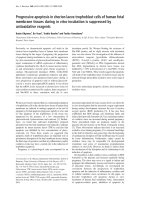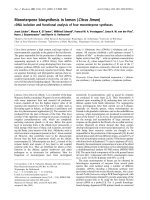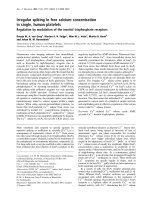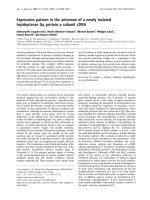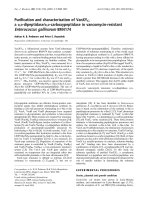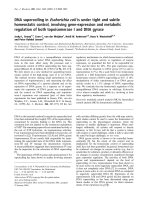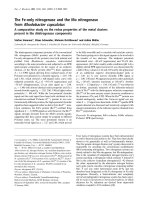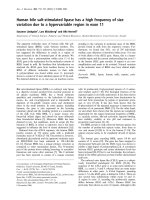Báo cáo y học: "Chemical restraint in routine clinical practice: a report from a general hospital psychiatric ward in Greece" ppsx
Bạn đang xem bản rút gọn của tài liệu. Xem và tải ngay bản đầy đủ của tài liệu tại đây (183.04 KB, 3 trang )
PRIMARY RESEARCH Open Access
Chemical restraint in routine clinical practice: a
report from a general hospital psychiatric ward
in Greece
Nikolaos Bilanakis
1
, Georgios Papamichael
1
, Vaios Peritogiannis
2*
Abstract
Background: There is a dearth of studies regarding chemical restraint in routine clinical psychiatric practice. There
may be wide variations between different settings and countries.
Methods: A retrospective study on chemical restraint was performed in the 11-bed psychiatric ward of the General
Hospital of Arta, in northwestern Greece. All admissions over a 2-year-period (from March 2008 to March 2010)
were examined.
Results: Chemical restraint was applied in 33 cases (10.5% of total admissions). From a total of 82 injections, 22
involved a benzodiazepine and/or levomepromazine, whereas 60 injections involved an antipsychotic agent, almost
exclusively haloperidol (96.7% of cases), usually in combination with a benzodiazepine (61.7% of cases). In 36.4% of
cases the patient was further subjected to restraint or seclusion.
Conclusions: In our unit, clinicians prefer the combined antipsychotic/benzodiazepine regimen for the
management of patients’ acute agitation and violent behaviour. Conventional antipsychotics are administrated
almost exclusively and in a significant proportion of cases further coercive measures are applied. Studies on the
practice of chemical rest raint should be regularly performed in clinical settings.
Introduction
Coercive measures are commonly used in psychiatric
treatment for the management of behaviour in patients
who are disturbed, although the need for alternatives
has been widely recognised [1]. Most a uthors focus on
seclusion and physical restraint, whereas chemical (phar-
maceutical) restraint or rapid tranquilisation has gained
little attention in the recent literature. We have pre-
viously reported on the pr actice of restraint and seclu-
sion in Greece [2] and the patients and families
attitudes towards coercive measures [3]. Here, we report
on the practice of chemical restraint in a psychiatric
ward within a general hospital.
Methods
A total of 314 admissions in the 11-bed psychiatric ward
of the General Hospital of Arta in northwestern Greece
from a 2-year-period (March 20 08 to March 2010) were
examined retro spectively. Rapid tranquilisation (defined
as emergency intramuscular drug administration for the
management of patients’ acute agitation and violent
behaviour) was applied in 33 cases (10.5% of total
admissions), involving 24 patients in different hospitali-
sation events. A total of 14 patients (58.3%) were male
and the age range of the patients wa s between 25 and
75 years (mean 46.9 years). Regarding diagnosis, 16
patients (66.7%) suffered from schizophrenia and related
psychoses and 4 patients (16.7%) from bipolar disorder,
being in a manic episode at admis sion. On 21 occasions
(63.6%), patients had been admitted involuntarily.
Results
The total number of injections given was 82. In the
majority of cases (24 cases, 72.7%) only 1 or 2 injections
had been required for the management of agitation and
violent behaviour. A total of 22 injections involved a ben-
zodiazepine (mostly diazepam, due to limited availability
of lorazepam in our unit) and/or levomepromazine, a
* Correspondence:
2
Private Practice, Ioannina, Greece
Full list of author information is available at the end of the article
Bilanakis et al. Annals of General Psychiatry 2011, 10:4
/>© 2011 Bilanakis et al; licensee BioMed Central Ltd. This is an Open Access article distributed under the terms of the Creative
Commons Attribution License ( ), which pe rmits unrestricted use, distribution, and
reproduction in any medium, provided the original work is properly cited.
sedative agent with only weak antipsychotic effects. In all,
60 injections (73.2%) involved an antipsychotic agent,
almost exclusively haloperidol (58 injections or 96.7%),
usually in combination with a benzodiazepine (in 37 out
of 60 cases, 61.7%). The administrated dosages were
greater than 300 mg equivalent to chlorpromazine on
eight occasions.
In 12 cases (36.4%) the patient was further subjected
to restraint or seclusion. Such combination of coercive
measures was clinica lly justified f or the most effective
management of the patients’ aggressive and violent
behaviour, and is commonly used in inpatient psychia-
tric units throughout the world [4,5].
Statistical analysis was not performed due to the
limited number of cases.
Discussion
These results suggest that clinicians in our unit t end to
use antipsychotic agents, usually in combination with a
benzodiazepine, for the management of severely dis-
turbed patients, whereas in a significant proportion of
cases further coercive measures are applied. Conven-
tional agents are almost exclusively preferred despite the
availability of atypical antipsychoti cs parenteral formula-
tions in our unit. The reasons for this are not known,
but we assume that practicing clinicians are more famil-
iar with the parenteral use of conventional antipsycho-
tics since they have been using these agents for long.
Moreover, they may be convinced of the efficacy and
safety of these agents according to their clinical experi-
ence. However, in recent years parenteral formulations
of several atypical antipsychotics have been developed,
and they are now available in the market. These agents
have been reported to be safe and better t olerated than
conventional antipsychotics, and they are now consid-
ered as effective and safe treatments for acute agitation
[6]. However, the evidence for the effectiveness of these
agents has been questioned because they have been stu-
died in patient populations that are less severely agitated
than ‘real world’ patients [7]. The administrated doses of
conventional antipsychotics were rather conservative (<
300 mg equivalent to chlorpromazine), probably du e to
the preferred combination with a benzodiazepine.
The results of our study may be considered clinically
relevant, because they involve every day clinical practice,
yet they must be viewed with caution. The number of
patients is small and the setting is a psychiatric ward
within a general hospital. As this is the first report on
the use of rapid tranquilisation from Greece there are
no relative data available for national comparisons, thus
conclusions cannot be reached. The tendency for the
use of conv entional antipsychotics for the management
of inpatient agitation may not be the case in other gen-
eral hospital psychiatric wards or psychiatric hospitals in
our country. It should be noted, however, that the prac-
tice of chemical restraint in our unit corresponds well
to the recommendations of the two existing guidelines,
the U K National Institute o f Clinical Excellence (NICE)
guideline on the short-term management of violent
behaviour [8] and the German guideline on treatment of
aggressive behaviour [9]. According to these guid elines
there is good evidence that benzodiazepines (mainly lor-
azepam) and antipsychotic s are effective and reasonably
safe for use in rapid tranquilisation. The limited avail-
ability of lorazepam in our unit provides a rationale for
the extensive use of antipsycho tics (73 .2% of injections )
as emergency medications. R egarding the application of
additional coercive measures to a significant prop ortion
of patients (36.4%), it should be mentioned that it is not
contraindicated according to the NICE guideline [8].
To date there are no national guidelines in Greece
regarding the use of rapid tranquilisati on and other
coercive measures, and psychiatrists rely on their clinical
experience for the management of agitation, or they fol-
low guidelines from other countries. The application of
such measures largely depends on local rules and prac-
tices [10], so it is expected that there may be wide varia-
tion in practice pattern within and between countries, as
demonstrated in a recent European study [11]. We
therefore believe that reports on c hemical restraint are
clinically relevant and studies on this topic should be
regularly performed. The establishment of national
guidelines in accordance with international proposed
guidelines [12] may result in the harmonisation of the
practices of Greek units with other units worldwide.
Author details
1
Department of Psychiatry, General Hospital of Arta, Arta, Greece.
2
Private
Practice, Ioannina, Greece.
Authors’ contributions
NB conceived the study, and participated in its design and coordination and
helped to draft the manuscript. GP participated in the study design and
collected the data. VP helped in the data collection and the writing of the
manuscript. All authors read and approved the final manuscript.
Competing interests
The authors declare that they have no competing interests.
Received: 4 November 2010 Accepted: 24 February 2011
Published: 24 February 2011
References
1. Donat D: Encouraging alternatives to seclusion, restraint, and reliance on
PRN drugs in a public psychiatric hospital. Psychiatr Serv 2005,
56:1105-1108.
2. Bilanakis N, Kalampokis G, Christou K, Peritogiannis V: Use of coercive
physical measures in a Psychiatric Ward of a General Hospital in Greece.
Int J Soc Psychiatry 2010, 56:402-411.
3. Bilanakis N, Peritogiannis V: Attitudes of patients and families toward
restraint and seclusion. Psychiatr Serv 2008, 59:1220.
4. Wynn R: Medicate, restraint or seclude? Strategies for dealing with
violent and threatening behaviour in a Norwegian university psychiatric
hospital. Scand J Caring Sci 2002, 16:287-291.
Bilanakis et al. Annals of General Psychiatry 2011, 10:4
/>Page 2 of 3
5. Abderhalden C, Needham I, Dassen T, Halfens R, Fischer JE, Haug HJ:
Frequency and severity of aggressive incidents in acute psychiatric
wards in Switzerland. Clin Pract Epidem Ment Health 2007, 3:30.
6. Canas F: Management of agitation in the acute psychotic patient-efficacy
without excessive sedation. Eur Neuropsychopharmacol 2007, 17:S108-S114.
7. Currier G: The controversy over “chemical restraint” in acute care
psychiatry. J Psychiatr Pract 2003, 9:59-70.
8. National Institute of Clinical Excellence: Violence - The short-term
management of disturbed/violent behavior in in-patient psychiatric settings
and emergency departments. Guideline No 25 London, UK: NICE; 2005.
9. German Society for Psychiatry, Psychotherapy, and Neurology: Therapeutic
Measures in Aggressive Behavior in Psychiatry and Psychotherapy Darmstadt,
Germany: Steinkopff; 2009, [in German].
10. Keski-Valkama A, Sailas E, Eronen M, Koivisto AM, Lonnqvist J, Kaltiala-
Heino R: A 15-year national follow-up. Legislation is not enough to
reduce the use of seclusion and restraint. Soc Psychiatr Psychiatric Epidem
2007, 42:747-752.
11. Steinert T, Lepping P: Legal provisions and practice in the management
of violent patients. A case vignette study in 16 European countries. Eur
Psychiatry 2009, 24:135-141.
12. Allen M, Currier G, Carpenter D, Ross R, Docherty J: Expert consensus
guidelines on the treatment of behavioral emergencies. J Psychiatr Pract
2005, 11(Suppl 1):1-108.
doi:10.1186/1744-859X-10-4
Cite this article as: Bilanakis et al.: Chemical restraint in routine clinical
practice: a report from a general hospital psychiatric ward in Greece.
Annals of General Psychiatry 2011 10:4.
Submit your next manuscript to BioMed Central
and take full advantage of:
• Convenient online submission
• Thorough peer review
• No space constraints or color figure charges
• Immediate publication on acceptance
• Inclusion in PubMed, CAS, Scopus and Google Scholar
• Research which is freely available for redistribution
Submit your manuscript at
www.biomedcentral.com/submit
Bilanakis et al. Annals of General Psychiatry 2011, 10:4
/>Page 3 of 3

